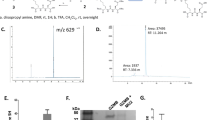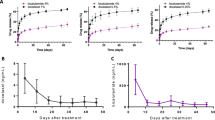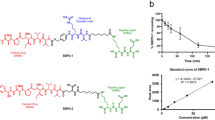Abstract
PSA, which is overexpressed in prostate carcinoma, represents a molecular target for selectively releasing an anticancer agent from a prodrug formulation. In this study, we report on the in vivo antitumor efficacy of an efficacious albumin-binding prodrug of doxorubicin (PSA9) that incorporates p-aminobenzyloxycarbonyl (PABC) as a self-immolative spacer in addition to the heptapeptide, Arg-Ser-Ser-Tyr-Tyr-Ser-Leu, which serves as a substrate for PSA. The prodrug is cleaved very efficiently by PSA releasing H-Ser-Leu-PABC-doxorubicin and subsequently doxorubicin in PSA-positive cell lysates and prostate tumor homogenates as the final cleavage product. PSA9 at 3 × 6 mg kg−1 doxorubicin equivalents (intravenous) was compared with conventional doxorubicin at equitoxic doses (at 3 × 3 mg kg−1; intravenous) in an orthotopic mouse model of prostate cancer using LNCaP lentiviral luciferase-neomycin cells transduced with luciferase. Whereas doxorubicin did not show any efficacy against the primary tumor or metastases, the prodrug reduced the primary tumor by 30–50% and circulating PSA levels, and in addition, showed a pronounced reduction in lung and bone metastases by ∼77% and ∼96%, respectively, and a positive trend regarding the activity against liver and lymph-node metastases compared with control and doxorubicin-treated animals. The incorporation of PABC as a self-immolative spacer together with a PSA substrate demonstrates superior antitumor effects over doxorubicin attributed to an efficient cleavage by PSA releasing doxorubicin as the final active agent in prostate tumor homogenates. Using this approach for developing effective prodrugs against prostate cancer, is worthy of further preclinical optimization.
This is a preview of subscription content, access via your institution
Access options
Subscribe to this journal
Receive 4 print issues and online access
$259.00 per year
only $64.75 per issue
Buy this article
- Purchase on Springer Link
- Instant access to full article PDF
Prices may be subject to local taxes which are calculated during checkout





Similar content being viewed by others
References
Jaeger EB, Samant RS, Rinker-Schaeffer CW . Metastasis suppression in prostate cancer. Cancer Metastasis Rev 2001; 20: 279–286.
Serretta V, Altieri V, Morgia G, Siragusa A, De Grande G, Napoli M et al. Oral chemotherapy in hormone-refractory prostate carcinoma patients unwilling to be admitted to hospital. Urol Int 2009; 83: 452–457.
Arlen PM, Gulley JL . Docetaxel-based regimens, the standard of care for metastatic androgen-insensitive prostate cancer. Future Oncol 2005; 1: 19–22.
Armstrong AJ, Garrett-Mayer ES, Yang YC, de Wit R, Tannock IF, Eisenberger M . A contemporary prognostic nomogram for men with hormone-refractory metastatic prostate cancer: a TAX327 study analysis. Clin Cancer Res 2007; 13: 6396–6403.
Armstrong AJ, Carducci MA . Chemotherapy for advanced prostate cancer: results of new clinical trials and future studies. Curr Oncol Rep 2005; 7: 220–227.
Calabro F, Sternberg CN . Current indications for chemotherapy in prostate cancer patients. Eur Urol 2007; 51: 17–26.
Denmeade SR, Nagy A, Gao J, Lilja H, Schally AV, Isaacs JT . Enzymatic activation of a doxorubicin-peptide prodrug by prostate-specific antigen. Cancer Res 1998; 58: 2537–2540.
DeFeo-Jones D, Garsky VM, Wong BK, Feng DM, Bolyar T, Haskell K et al. A peptide-doxorubicin ‘prodrug’ activated by prostate-specific antigen selectively kills prostate tumor cells positive for prostate-specific antigen in vivo. Nat Med 2000; 6: 1248–1252.
Graeser R, Chung DE, Esser N, Moor S, Schachtele C, Unger C et al. Synthesis and biological evaluation of an albumin-binding prodrug of doxorubicin that is cleaved by prostate-specific antigen (PSA) in a PSA-positive orthotopic prostate carcinoma model (LNCaP). Int J Cancer 2008; 122: 1145–1154.
Kratz F . Albumin as a drug carrier: design of prodrugs, drug conjugates and nanoparticles. J Control Release 2008; 132: 171–183.
Maeda H, Wu J, Sawa T, Matsumura Y, Hori K . Tumor vascular permeability and the EPR effect in macromolecular therapeutics: a review. J Control Release 2000; 65: 271–284.
Kratz F, Warnecke A, Schmid B, Chung DE, Gitzel M . Prodrugs of anthracyclines in cancer chemotherapy. Curr Med Chem 2006; 13: 477–523.
Kratz F . DOXO-EMCH (INNO-206): the first albumin-binding prodrug of doxorubicin to enter clinical trials. Expert Opin Investig Drugs 2007; 16: 855–866.
Elsadek B, Graeser R, Warnecke A, Unger C, Saleem T, El-Melegy N et al. Optimization of an albumin-binding prodrug of doxorubicin that is cleaved by prostate-specific antigen (PSA). ACS Med Chem Lett 2010; 1: 234–238.
Carl PL, Chakravarty PK, Katzenellenbogen JA . A novel connector linkage applicable in prodrug design. J Med Chem 1981; 24: 479–480.
Workman P, Balmain A, Hickman JA, McNally NJ, Rohas AM, Mitchison NA et al. UKCCCR guidelines for the welfare of animals in experimental neoplasia. Lab Anim 1988; 22: 195–201.
Demaison C, Parsley K, Brouns G, Scherr M, Battmer K, Kinnon C et al. High-level transduction and gene expression in hematopoietic repopulating cells using a human immunodeficiency [correction of imunodeficiency] virus type 1-based lentiviral vector containing an internal spleen focus forming virus promoter. Hum Gene Ther 2002; 13: 803–813.
Zhang F, Thornhill SI, Howe SJ, Ulaganathan M, Schambach A, Sinclair J et al. Lentiviral vectors containing an enhancer-less ubiquitously acting chromatin opening element (UCOE) provide highly reproducible and stable transgene expression in hematopoietic cells. Blood 2007; 110: 1448–1457.
Bornmann C, Graeser R, Esser N, Ziroli V, Jantscheff P, Keck T et al. A new liposomal formulation of Gemcitabine is active in an orthotopic mouse model of pancreatic cancer accessible to bioluminescence imaging. Cancer Chemother Pharmacol 2008; 61: 395–405.
Kossodo S, Pickarski M, Lin SA, Gleason A, Gaspar R, Buono C et al. Dual in vivo quantification of integrin-targeted and protease-activated agents in cancer using fluorescence molecular tomography (FMT). Mol Imaging Biol 2010; 12: 488–499.
Hilderbrand SA, Weissleder R . Near-infrared fluorescence: application to in vivo molecular imaging. Curr Opin Chem Biol 2010; 14: 71–79.
Denmeade SR, Sokoll LJ, Chan DW, Khan SR, Isaacs JT . Concentration of enzymatically active prostate-specific antigen (PSA) in the extracellular fluid of primary human prostate cancers and human prostate cancer xenograft models. Prostate 2001; 48: 1–6.
Ravery V, Boccon-Gibod L . Free/total prostate-specific antigen ratio—hope and controversies. Eur Urol 1997; 31: 385–388.
Acknowledgements
The financial supports of the Dietmar Hopp Foundation, Germany, and the Cultural Affairs and Missions Sector, Egyptian Ministry of Higher Education are gratefully acknowledged.
Author information
Authors and Affiliations
Corresponding author
Ethics declarations
Competing interests
The authors declare no conflict of interest.
Rights and permissions
About this article
Cite this article
Elsadek, B., Graeser, R., Esser, N. et al. In vivo evaluation of a novel albumin-binding prodrug of doxorubicin in an orthotopic mouse model of prostate cancer (LNCaP). Prostate Cancer Prostatic Dis 14, 14–21 (2011). https://doi.org/10.1038/pcan.2010.43
Received:
Revised:
Accepted:
Published:
Issue Date:
DOI: https://doi.org/10.1038/pcan.2010.43
Keywords
This article is cited by
-
Albumin nanoscience: homing nanotechnology enabling targeted drug delivery and therapy
Archives of Pharmacal Research (2020)
-
Enhanced anti-tumor activity of the Multi-Leu peptide PACE4 inhibitor transformed into an albumin-bound tumor-targeting prodrug
Scientific Reports (2019)
-
Cytosine arabinoside prodrug designed to bind plasma serum albumin for drug delivery
Drug Delivery and Translational Research (2018)
-
Zosuquidar and an albumin-binding prodrug of zosuquidar reverse multidrug resistance in breast cancer cells of doxorubicin and an albumin-binding prodrug of doxorubicin
Breast Cancer Research and Treatment (2012)



